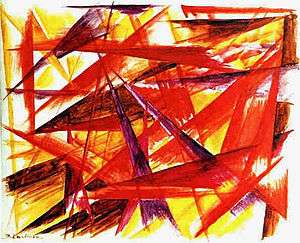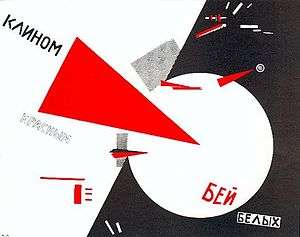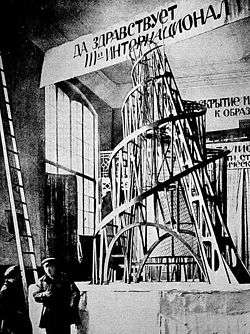Russian avant-garde
.jpg)






The Russian avant-garde was a large, influential wave of modern art that flourished in the Russian Empire and Soviet Union, approximately 1890 to 1930—although some have placed its beginning as early as 1850 and its end as late as 1960. The term covers many separate, but inextricably related, art movements that flourished at the time; namely Suprematism, Constructivism, Russian Futurism, Cubo-Futurism, Zaum and Neo-primitivism. Given that many avant-garde artists involved were born or grew up in what is present day Belarus and Ukraine (including Kazimir Malevich, Aleksandra Ekster, Vladimir Tatlin, Wassily Kandinsky, David Burliuk, Alexander Archipenko), some sources also talk about Ukrainian avant-garde.
The Russian avant-garde reached its creative and popular height in the period between the Russian Revolution of 1917 and 1932, at which point the ideas of the avant-garde clashed with the newly emerged state-sponsored direction of Socialist Realism.
Artists and Designers
Notable figures from this era include:
- Alexander Archipenko
- Vladimir Baranoff-Rossine
- Alexander Bogomazov
- David Burliuk
- Vladimir Burliuk
- Marc Chagall
- Ilya Chashnik
- Aleksandra Ekster
- Robert Falk
- Moisey Feigin
- Pavel Filonov
- Artur Fonvizin
- Naum Gabo
- Nina Genke-Meller
- Natalia Goncharova
- Elena Guro
- Vasily Kandinsky
- Lazar Khidekel
- Ivan Kliun
- Gustav Klutsis
- Pyotr Konchalovsky
- Eugène Konopatzky
- Sergei Arksentevich Kolyada
- Alexander Kuprin
- Mikhail Larionov
- Aristarkh Lentulov
- El Lissitzky
- Kazimir Malevich
- Paul Mansouroff
- Ilya Mashkov
- Mikhail Matyushin
- Vadim Meller
- Adolf Milman
- Solomon Nikritin
- Alexander Osmerkin
- Liubov Popova
- Ivan Puni
- Kliment Red'ko
- Alexei Remizov
- Alexander Rodchenko
- Olga Rozanova
- Léopold Survage
- Varvara Stepanova
- Georgii and Vladimir Stenberg
- Vladimir Tatlin
- Vasiliy Yermilov
- Nadezhda Udaltsova
- Ilya Zdanevich
- Alexandr Zhdanov
Journals
Filmmakers
- Grigori Aleksandrov
- Boris Barnet
- Alexander Dovzhenko
- Sergei Eisenstein
- Lev Kuleshov
- Yakov Protazanov
- Vsevolod Pudovkin
- Dziga Vertov
Writers
- Andrei Bely
- Elena Guro
- Velimir Khlebnikov
- Daniil Kharms
- Aleksei Kruchenykh
- Vladimir Mayakovsky
- Viktor Shklovsky
- Sergei Tretyakov
- Marina Tsvetaeva
- Sergei Yesenin
- Ilya Zdanevich
Theatre Directors
Architects
- Yakov Chernikhov
- Moisei Ginzburg
- Ilya Golosov
- Ivan Leonidov
- Konstantin Melnikov
- Vladimir Shukhov
- Alexander Vesnin
Preserving Russian avant-garde architecture has become a real concern for historians, politicians and architects. In 2007, the Modern Museum of Art MoMA in New York, devoted an exhibition entirely to the *Lost Vanguard: Soviet Architecture, featuring the work of American Photographer Richard Pare.
Composers
- Samuil Feinberg
- Arthur Lourié
- Mikhail Matyushin
- Nikolai Medtner
- Alexander Mossolov
- Nikolai Myaskovsky
- Nikolay Borisovich Obukhov
- Gavriil Popov
- Sergei Prokofiev
- Nikolai Roslavets
- Leonid Sabaneyev
- Alexander Scriabin
- Vissarion Shebalin
- Dmitri Shostakovich
Many Russian composers that were interested in avant-garde music became members of the Association for Contemporary Music which was headed by Roslavets.
Main articles
- Constructivist architecture
- Soviet montage theory
- Universal Flowering
- Russian symbolism
- Jack of Diamonds
- Russian Futurism
- Cubo-Futurism
- Constructivism
- Suprematism
- Avant-garde
- Vkhutemas
- Proletkult
- Soviet art
- Rayonism
- UNOVIS
References
- Friedman, Julia. Beyond Symbolism and Surrealism: Alexei Remizov's Synthetic Art, Northwestern University Press, 2010. ISBN 0-8101-2617-6 (Trade Cloth)
- Russian avant-garde on YouTube - video
- Kovalenko, G.F. (ed.) The Russian Avant-Garde of 1910-1920 and Issues of Expressionism. Moscow: Nauka, 2003.
- Shishanov V.A. Vitebsk Museum of Modern Art: a history of creation and a collection. 1918-1941. - Minsk: Medisont, 2007. - 144 p.
- “Encyclopedia of Russian Avangard. Fine Art. Architecture Vol.1 A-K, Vol.2 L-Z Biography”; Rakitin V.I., Sarab’yanov A.D., Mosсow, 2013
Surviving Suprematism: Lazar Khidekel. Judah L. Magnes Museum, Berkeley CA, 2004 Lazar Khidekel and Suprematism. Prestel, 2014 (Regina Khidekel, with contributions by Constantin Boym, Magdalena Dabrowski, Charlotte Douglas, Tatyana Goryacheva, Irina Karasik, Boris Kirikov and Margarita Shtiglits, and Alla Rosenfeld)
External links
- Why did Soviet Photographic Avant-garde decline?
- The Russian Avant-garde Foundation
- Thessaloniki State Museum of Contemporary Art - Costakis Collection
- Yiddish Book Collection of the Russian Avant-Garde at the Beinecke Rare Book and Manuscript Library at Yale University
- International campaign to save the Shukhov Tower in Moscow
- Masters of Russian Avant-garde
- Masters of Russian Avant-garde from the collection of the M.T. Abraham Foundation




.jpg)